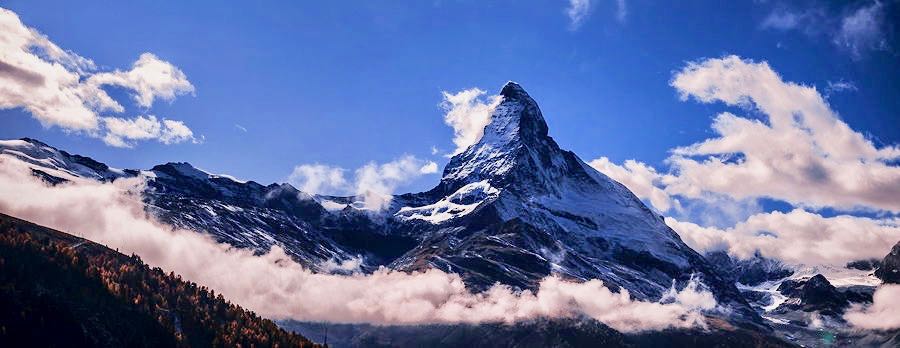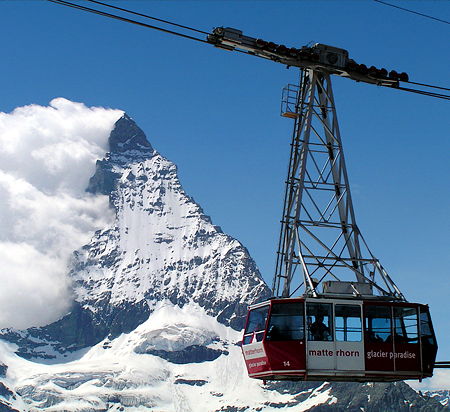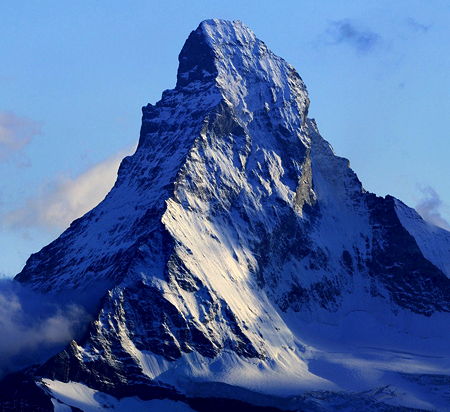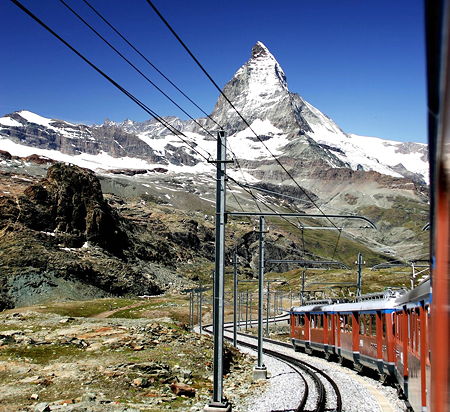Climbing the Matterhorn, Switzerland
The 4478 metre (14,687 foot) Matterhorn was, in 1865, the last of the great Alpine peaks to be climbed.
The Matterhorn, known in France as Mont Cervin and in Italy as Monte Cervino, is world-famous on account of its classic mountain shape and infamous first ascent. While most are content to admire it from a distance, it is also popular summit for climbers and mountaineers.
This page describes the various routes to the summit of the Matterhorn, including the most popular Hörnli Ridge from the Hörnlihutte above Zermatt. It also provides information about the mountain's chequered history, advice on the physical and technical training you will need to undertake, and the kit you will need to bring.
1. Routes up the Matterhorn
The Hörnli Ridge

The easiest route to the summit of the Matterhorn is the Hörnli Ridge. This involves 1,220 metres of ascent from the Hörnli Hut (aka the Hörnlihütte). It is the usual route for those staying in Zermatt, and roughly follows the Matterhorn's north east ridge.
The Hörnli Ridge is graded AD. The climb is not technically demanding. It requires basic short-roping and crampon skills and is for the most part a long scramble with a few sections of fairly easy climbing (fixed ropes are placed on the most difficult sections). The climb is usually started at about 4am, with the first half being completed in darkness. This allows alpinists to finish the climb in good weather and to get back to Zermatt.
The Hörnli Ridge is nevertheless a serious climb, for three reasons.
- It is a long climb and so requires you to be really fit. Time spent on the mountain ranges from 8 to 12 hours.
- It is very exposed and so you need to concentrate from your first step. It is also one of the Alps most popular peaks: so you have to keep your wits about you when overtaking or passing other climbers.
- The high altitude: at 4,478 metres, the Matterhorn is the sixth highest peak in the Alps.
Other routes
Other normal routes to the summit include the Lion’s Ridge from the Italian side of the mountain, graded AD, and the Zmutt Ridge, accessed from the Hörnli Hut, which is a long and exposed climb graded D.
The last two regular routes are for hard-core mountaineers only. The Furggen route is the most difficult ridge climb, graded D+/TD. And the North Face, one of the classic Alpine north faces, is graded TD. The usual Schmidt route up the north face involves steep ice and climbing at IV and V, delicate unstable rock, and takes 10-12 hours. Many climbers will spend a night on the north face or bivouacking on the summit.
2. Training for the Matterhorn
The key to climbing the Matterhorn is the ability to move quickly over moderately difficult terrain for a sustained period of time.
In the gym
If you are training in a gym, we suggest working on general fitness and endurance. Use a Stairmaster, stepper or versa climber if you can.
You should also work on your upper body strength, which becomes important when hauling yourself up the Matterhorn’s fixed ropes. Practice rope climbing if possible, and if not spend time on pull-ups, chin-ups and dips for your triceps.
At the climbing wall
If you have access to an indoor climbing wall, then focus on endurance; when we trained, we went round and round a traversing wall for up to an hour at a grade of V0 or V1.
Outside
Outside, you should be aiming for ridge scrambles – the harder the better. Focus on technique and maintaining a steady pace of movement. You should also get used to climbing in mountain boots and whilst carrying a backpack. By the time you arrive in Zermatt, you should be comfortable climbing with boots and pack at V Diff.
You will also need crampon and ice-axe skills. These don't have to be learned in the Alps. Experience of climbing rock whilst wearing crampons can be important (especially if you are climbing after a recent snowfall). So this should try to practice this too.
In Zermatt
When you get to Zermatt, you will need to acclimatise to the altitude and get some more mountain metres in your legs. Ideally, aim to spend a week or so in Zermatt preparing for your climb (this should also allow you a weather window).
For fitness, we suggest the following:
| Mountain | Height | Ascent | Time |
|---|---|---|---|
| Wisshorn | 2911 metres | 1300 metres | 7 hours |
| Platthorn | 3343 metres | 1700 metres | 8-10 hours |
| Mettelhorn | 3403 metres | 1800 metres | 9-11 hours |
| Oberrothorn | 3415 metres | 1900 metres | 7 hours |
To hone your climbing skills for the Matterhorn, you should spend a day at the 2927 metre Riffelhorn. Take the Gornergrat mountain railway to the Rotenboden stop (2815 metres). The east ridge is a scramble with a few short pitches of climbing, and will take about 45 minutes. It is similar to some of the Matterhorn’s terrain. Then head to the far side of the mountain, to try the bolted routes (at difficulties of between 3 and 5a).
The Matterhorn probably shouldn't be your first Alpine 4000 metre peak. Instead, build up to it by tackling easier 4000-metre peaks in Zermatt such as Castor, Pollux and the Breithorn half-traverse.
3. Climbing the Hörnli Ridge
The climb starts from the Hörnli Hut (3260 m), which is accessed by way of 2-3 hour walk from the Schwarzsee cable car station (2588 m, the second stop on the route to the Glacier Paradise).
The Hörnli Hut offers dorms/basic rooms, hearty dinners and early breakfasts for those attempting the climb, and is a popular spot for tourists looking to inspect the Matterhorn close-up or watch climbers descending the mountain.
The climb itself starts about two hours before dawn (ie between 3 and 5 am), with climbers lining up inside the hut (pictured) and making a dash for the first piece of vertical ascent. Once you get over this 10-metre pitch, you will find yourself on easier terrain: typically moderately difficult scrambling.
The Solvay Refuge
It takes about 2-3 hours to reach the Solvay Refuge (4003 m, a small emergency hut), which marks the half-way point in terms of time and the two-thirds point in terms of ascent. Most of this leg will take place in the dark, so make sure you bring a good head torch. If you arrive in time to see sunrise, you are doing well.
Just before and after the Solvay Hut are found the lower and upper Moseley slabs—pitches of V Diff rock climbing named after an American climber who perished here in the late 19th century.
The Shoulder and Icefield
After the Solvay Hut, the terrain becomes a little more challenging. There is the Upper Moseley slab to negotiate, followed by scrambling until you reach The Shoulder where the route gets more vertical. Thick fixed ropes have been placed on most of the exposed sections, so make sure you are used to hauling yourself up them.
About 200 metres from the summit, you will reach the Summit Icefield and start to zig-zag your way up to the first statue of Madonna. At 40 degrees, the route is not particularly steep, but you need to watch out for other climbers.
The Summit and descent
From the Madonna, the terrain levels off and, after taking care on a narrow arête, you are at the summit.
The panorama from the top of the Matterhorn is amazing: nearby 4000-metre giants include the Dent Blanche, Ober Gabelhorn, Zinalrothorn, Weisshorn, Monte Rosa and Liskamm. You will also be able to see Mont Blanc, Dent d'Herens and Grand Combin to the west.
Take in water and food, catch your breath, and steel yourself for a challenging descent. The descent takes about the same time as the ascent (though the Hörnli Hut looks deceptively close).
Take your time and be careful: you will be tired.
When is the best time to climb?
Peak season is mid-July to mid-September, after the winter snow has melted from most of the route and before the colder and less stable weather of autumn.
But be warned: the weather in the Alps is notoriously unpredictable, and heavy rain in Zermatt will mean snow on the Hörnli Ridge—making it at best more difficult and at worst closing the route until the snow has melted.
If you can, give yourself a weather window of three or so days for your climb.
4. Should I take a guide?
There is much that is magical about the Matterhorn, but a negative is definitely its popularity. On good weather days in summer, you will share the route with up to 100 others.
Popularity
The popularity of the mountain makes the route much more dangerous: holds are polished, the risk of rock fall is increased, and great care must be taken when overtaking slower climbers or passing climbers on their way up/down. On an average year, over 3,000 climbers reach the summit between July and September (though the weather was so poor in 2014 that only a few hundred made it).
Deaths on the mountain
Over 500 people have died trying to climb the Matterhorn from Zermatt. Though the climb has become far safer over recent years, with the increased use of guides and fixed ropes and more advanced rescue techniques, there remain about three fatalities each year.
One website ranks the Matterhorn as the world's sixth most dangerous mountain (Everest is ranked ninth).
Why take a Guide?
There are at least three advantages to using a guide to climb the Matterhorn, even for the more experienced mountaineer.
- Guides are allowed to leave the Hörnli Hut first – so your chances of being caught in a traffic jam are reduced.
- Route-finding on the Matterhorn is difficult for those who do not know the mountain.
- The Matterhorn is a very exposed climb; being short-roped and belayed by a guide makes things a lot safer.
Many companies offer Matterhorn weeks, which are designed to cover the skills needed to climb the Matterhorn and assist with acclimatisation. They are a good way to maximise your prospects of reaching the top.
5. The Matterhorn's history
The Golden Age of Alpinism started in about 1854, with Alfred Willis’ ascent of the Wetterhorn. Its heroes were typically upper-class English climbers who travelled to the Alps by train and hired Swiss or French guides. On such climber was Edward Whymper.
In the years that followed, the classic alpine peaks were conquered: Mont Blanc in 1855, the Monch in 1857, the Weisshorn in 1861, Dent Blanche in 1862, and the Zinalrothorn in 1864.
Whympher's first ascent
The race was therefore on to see who would be first to conquer the Matterhorn. Whymper had made previous attempts, and in July 1865 hired two Zermatt guides to accompany him and the rest of his party. At the same time, Jean-Antoine Carrel and Jean-Baptiste Bich were preparing to climb the Matterhorn from the Italian side.
Whymper’s party made it to the summit on 14 July 1865, beating the Italian party by two days. They spent "one crowded hour of glorious life" on the top. But disaster struck on descent. One of Whymper’s party of seven slipped, pulling three other climbers off the mountain with him. Whymper and the Zermatt guides survived.
Whymper was later accused of cutting the rope, though an official enquiry found no evidence to support the allegation. The accident was so high profile and controversial that Queen Victoria gave consideration to banning British citizens from engaging in mountaineering.
Matterhorn records
More recently, the record for the fastest ascent of the Matterhorn was shattered by Spanish mountain runner Killian Journet. Tackling the mountain from the Italian village of Cervinia, Journet’s time for the round-trip to the summit was a mind-boggling 2 hours 52 minutes 2 seconds.
The Mountain's 150th Anniversary
2015 saw the 150th anniversary of the Matterhorn's first ascent. Zermatt put on a number of celebratory events: there was a countdown clock in the Bahnhofplatz; a series of performances inspired by Whymper's feat in a 700-seater open-air theatre on the mountainside; the outdoor equipment manufacturer Mammut and the Zermatt Mountain Guides illuminated the Hornli Ridge with red lights to highlight the route of Whymper's first ascent; and dignitaries from across the globe were invited to the celebrations held on 14 July.
6. The Hörnlihutte
The Hörnlihütte is a mountain hut marking the start of the Matterhorn climb, at an altitude of 3260 metres. It offers hearty dinners, early breakfasts, and accommodation in dorms or private room.
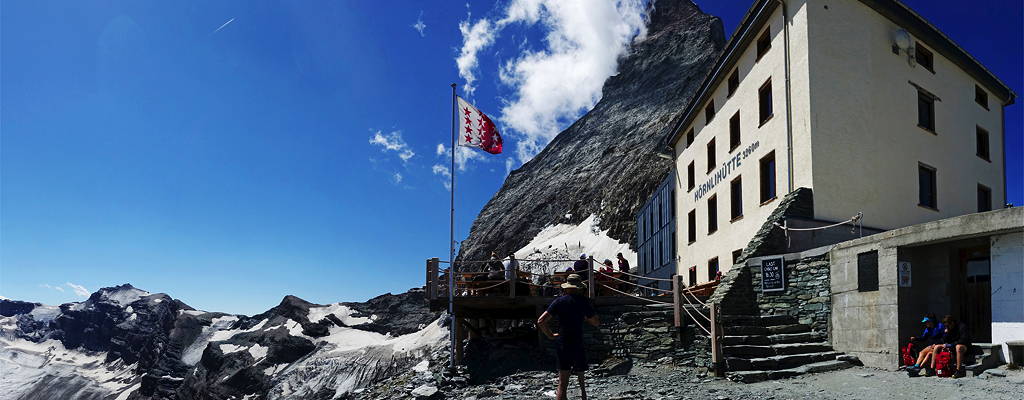
The Hörnlihütte was closed during 2014 for modernisation. This meant that climbers had to either stay at hotels at Schwarzsee or at the temporary Matterhorn Base Camp, found 400 metres beneath the Hörnlihütte, and erected for use between July and September 2014.
The redeveloped Hörnlihutte, complete with a new accommodation block, reopened on 1 July 2015 – 150 years after the Matterhorn was first climbed.
7. Equipment needed to climb the Matterhorn
| Equipment | Details |
|---|---|
| Helmet | a lightweight helmet with good ventilation is best |
| Head torch | the first half of the climb takes place in darkness; remember to check your batteries |
| Woolly hat/balaclava | Merino wool is recommended |
| Fleece | under your several layers one should be fleece |
| Waterproof gear | waterproof gear is always needed |
| Base layer | a base layer of clothing |
| Harness/Carabiners/Belay Device | the harness should be of the leightweight alpine variety |
| Gloves | take two pairs; gloves with a leather palm that will allow you to feel the rock are best |
| Ice Axe | for the icefield |
| Climbing trousers | make sure they wick sweat |
| Waterproof trousers | to be safe in case of rain |
| Boots | a lightweight, flexible B2 boot is best |
| Crampons | practice putting these on and taking them off |
| Camera | you won't want to miss taking a shot of this experience |
| Energy bars and food | to give you the needed boost on the ridge |
| Spare socks | you will always need these |
| Water | guides move quickly; so an insulated hydration tube is best |
| Sunscreen | make sure to take water resistent with you |
| Gaiters | these will keep your legs and feet comfortable/td> |
| Trekking pole | these will reduce the stress on your legs and lower body |
8. The costs
The Zermatt Alpine Centre offers guides for the Matterhorn for CHF1575.
Alternately, you can look for your own IFMGA guide. We recommend Marco Zaninetti, an Italian guide with lots of Matterhorn experience.
The Hörnlihutte's prices for 2018 have recently been announced: CHF150 per person for dinner, breakfast and accommodation in a six to eight person dorm. There is a CHF10 discount for members of the Swiss Alpine club. If you prefer privacy, you will have to pay for it: double rooms are available for CHF450.
The Hörnlihutte is open from 1 July to 20 September.
Finally, please be safe. Do not attempt the mountain if you do not have the necessary technical skills and experience; don't seek to climb in bad weather; take a guide; turn around and descend if the weather closes in. And remember Whymper's famous exhortation in Scrambles Amongst the Alps:
"Climb if you will, but remember that courage and strength are naught without prudence, and that a momentary negligence may destroy the happiness of a lifetime. Do nothing in haste; look well to each step; and from the beginning think what may be the end."
